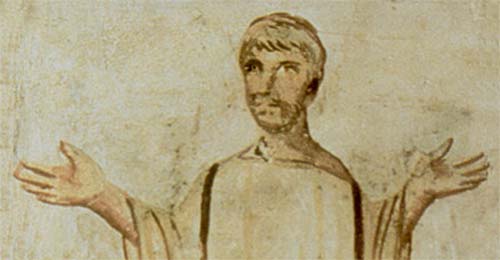Principle 2: Liturgical acts are not things to be done during prayer, but are themselves prayer
We all instinctively know when a hug is genuine, when a kiss is perfunctory, when someone is just “going through the motions”…
The second principle, above, comes from Celebrating the Eucharist by Patrick Malloy (The first principle is here).
A person at prayer does not always feel the emotions that would lead to … an authentic gesture. But the believer, trusting in the presence of God even when God seems absent, retains an attitude of reverence and wonder even when the immediate feelings are lacking. …”fake it ’til you make it.” At times in the liturgy, the feelings that ideally would accord with the gesture will escape us. That is when the gesture must emerge from a deeper and more enduring place: from a carefully nurtured attitude….
To pray with one’s body requires imagination. What are we doing when we are walking down the aisle? Is it just getting from here to there, or is it a snapshot of the march to the kingdom of God…
Likewise, the orans position is not merely aping of an ancient posture but can be a way of opening oneself in trust before God…
When the presider, the other liturgical ministers, and all the members of the assembly pray with the body and do not merely do prescribed bodily gestures while praying with the voice, an authenticity shines forth… (page 20)
Once again, this is very much the approach in my book Celebrating Eucharist, and a good example is in the chapter on posture and gesture.
Today is the Forty-eighth day of Easter.
Principle 1: The entire assembly celebrates the liturgy




Yes and Amen. Eliot’s words from Little Gidding are apposite:
If you came this way,
Taking any route, starting from anywhere,
At any time or at any season,
It would always be the same: you would have to put off
Sense and notion. You are not here to verify,
Instruct yourself, or inform curiosity
Or carry report. You are here to kneel
Where prayer has been valid. And prayer is more
Than an order of words, the conscious occupation
Of the praying mind, or the sound of the voice praying.
And what the dead had no speech for, when living,
They can tell you, being dead: the communication
Of the dead is tongued with fire beyond the language of the living.
Here, the intersection of the timeless moment
Is England and nowhere. Never and always.
Interesting insight. In contemporary/pentecostal style worship I see gesture and posture used a lot, but the more spontaneous nature of this culture is that it is usually “felt” by the worshipper who chooses to kneel, or raise hands, or even prostate themselves. Worship is understood as being about the whole person, including the body as well as the mind and spirit. I assume the same understanding underlies the movement and gestures in more traditional services.
It would be an interesting piece of research, Claudia – I suspect that at the start, for many (most?) it might be “felt” and “spontaneous”; and after some years or decades of such worship it may be “felt” less, and be less “spontaneous”. I suspect that also for some (many?) the gestures and postures are part of a cultural expectation, a group response. My point: I think that “the movement and gestures in more traditional services” are what one would expect in a tradition of spirituality going back 2,000 years (and 4,000 years…) Christ is Risen!
For some that would be true, Bosco.
My point was intended to show the two worship styles have more in common than differences. Gesture is prayer expressed physically. It can become habit in the same way praying the same verbal prayers can become habit. But it’s still prayer, whether written in a prayer book or using your own words, or a mixture of both.
Yes, Claudia. I was saying the same as you – the other side of the coin. And the same is true for your mention of a habit. Good habits are positive – a spiritual discipline. Blessings.
I love the drawing that goes with this post Bosco. Where’s it from?
I try, Clare, to put an image source if I can. I hope people know how to do an image search. Dragging and dropping this image gives this as Two Monks Bowing, Stanley Roseman, 1979, chalk on paper. Blessings.